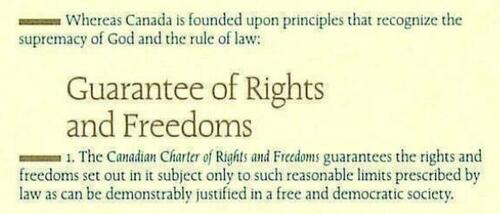Matt Taibi | Racket News
On February 21st, Canadian Prime Minister Justin Trudeau gave a press conference in Edmonton, announcing his government’s decision to introduce the Online Harms Act, or Bill C-63. It was described in Canadian media as a “bill to protect kids” that would stop the “exploitation of children,” and Trudeau’s curt speech focused solely on minors. The scarf-clad PM angrily dismissed criticisms the bill might have a broader focus.
“I look forward to putting forward that Online Harms bill, which people will see is very, very specifically focused on protecting kids, and not on censoring the Internet,” he said sharply. “I think everyone, wherever they are in the political spectrum, can agree that protecting kids is something governments should be focused on doing.”
Soon after, on February 26th, Trudeau’s government introduced the bill. Canada’s stable of retreating, credulous on-air personalities announced its rollout like the arrival of penicillin. “Tonight, Web of Harm,” gushed CTV’s Omar Sachedina. “Tackling online dangers and safeguarding children… The long-awaited framework for protecting the vulnerable…”
There was little initial uproar. What could be wrong with increasing child safety, or “protecting the vulnerable”?
Then people read the bill.
“If you look at the purpose of this law, it’s actually quite noble and most lawyers would agree with it,” says Canadian attorney Dan Freiheit. “Online safety, protecting children’s physical and mental health.” But the actual text?
“It’s wild,” Freheit says.
Trudeau was lying when he said C-63 was “very, very specifically focused on correcting kids.” The purview of the Online Harms Act extends far beyond speech, reimagining society as a mandated social engineering project, creating transformational new procedures that would:
- enlist Canada’s citizens in an ambitious social monitoring system, with rewards of up to $20,000 for anonymous “informants” of hateful behavior, with the guilty paying penalties up to $50,000, creating a self-funded national spying system;
- introduce extraordinary criminal penalties, including life in prison not just for existing crimes like “advocating genocide,” but for any “offence motivated by hatred,” in theory any non-criminal offense, as tiny as littering, committed with hateful intent;
- punish Minority Report pre-crime, where if an informant convinces a judge you “will commit” a hate offense, you can be jailed up to a year, put under house arrest, have firearms seized, or be forced into drug/alcohol testing, all for things you haven’t done;
- penalize past statements. The law gets around prohibitions against “retroactive” punishment by calling the offense “continuous communication” of hate, i.e. the crime is your failure to take down bad speech;
- force corporate Internet platforms to remove “harmful content” virtually on demand (within 24 hours in some cases), the hammer being fines of “up to 6% of… gross global revenue.”
Things you’re saying, things you’ve already said, things an administrative judge thinks you might say, all barred, with neighbors deputized as enforcers? Good times. Leave it to Trudeau, a frequent trailblazer in new forms of illiberalism in the digital age, to come up with this quantum leap downward on the rights front. C-63 is a Frankenstein’s Monster combining the worst censorship ideas already deployed by supposed ally government-in-laws like Europe’s Digital Services Act, Australia’s updated Australian Communications and Media Authority Act (ACMA), and Scotland’s Hate Crime and Public Order Act, which saw 7,152 complaints in its first week when the law took effect last month.
Trudeau’s creation is a turbo-charged social surveillance law aimed first at forcing big platforms like Facebook and Twitter to “self-police,” but secondarily targeting individuals and doling out civil and criminal penalties for speech and thought on a scale not seen anywhere. What constitutes hateful conduct? While the bill newly defines hate speech as “likely to foment detestation or vilification” of Canada’s growing list of protected groups and individuals, Canadian lawyers interviewed were generally unsure of what the standard might look like in practice.
“It’s impossible to know what exactly it’s going to mean,” says Bruce Pardy, Executive Director of Rights Probe. “So you’re going to have to rely upon the court in a criminal prosecution, or the human rights tribunal in a human rights proceeding, to put their own interpretation on that, and figure out where the line is.”
Despite being split on how serious the immediate impact might be (“We’re not looking at prisons full of people doing life for misgendering” said one), most attorneys seemed to agree C-63 will be a game-changer if passed, aimed beyond speech at the very concept of individual rights, chipping away at ideas like the presumption of innocence and the right to face one’s accuser, and using traditionally dubious tools like ex post facto laws.
On one level, it’s not surprising, given Canada’s historically diffident attitude toward rights — the first section in the country’s Charter of Rights and Freedoms, ironically introduced when Trudeau’s father Pierre was Prime Minister, is essentially a giant loophole — but this Prime Minister appears determined to swap out Canada’s reputation for brotherhood, humor, and generosity for a new one based on rigidity and collective paranoia.

RIGHTS, BUT: Canada guarantees the right to freedom of expression, but “only to such reasonable limits… as can be demonstrably justified.”
There’s a long backstory of important recent laws and Supreme Court cases that helped push Canada down a path toward C-63, but this bill still stands apart as a unique problem, and only a few domestic media outlets have been willing or able to criticize it. One of those is Rebel News, whose founder Ezra Levant says Canadians could really use America’s help in sounding the alarm. “Canadians need to fight for our own freedom, but the Canadian political and media establishment are obsessed by what U.S. journalists and politicians have to say about us,” Levant says. “So any attention Americans can bring to this civil liberties bonfire really makes a difference. Frankly, we need your help.”
How bad is C-63? See for yourself, in a tour through its key sections:
Subscribers to Racket can read the rest here…






